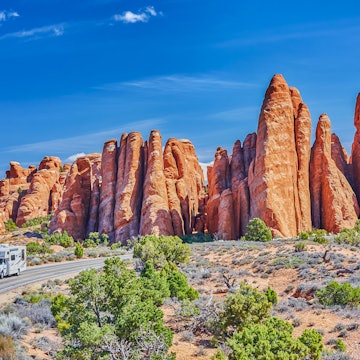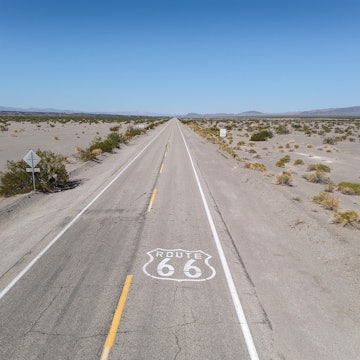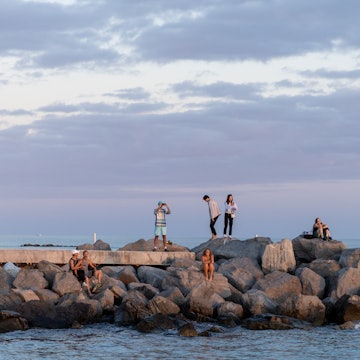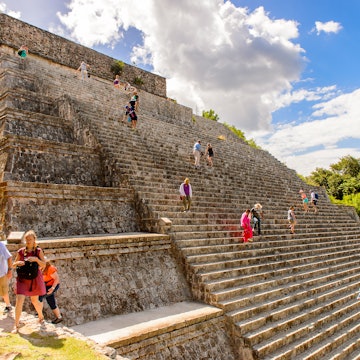

With its stunning deserts, a deep and varied history, and breathtaking natural beauty, New Mexico is unique. Traveller70/Shutterstock
Culture and scenery are king in New Mexico – in the 47th state you can explore petroglyphs and ancient adobe pueblos, visit old cathedrals and hundreds of art galleries or head off into the wilderness on desert trails to soaring granite rocks, before driving through maroon mesas to retro joints on Route 66.
When the heat of the desert gets too much – simply climb up higher to the cooler peaks with their groomed ski runs in winter and lofty pine-scented hikes in summer, before resting your aching muscles in a hidden natural hot spring.
New Mexico is known as the Land of Enchantment for good reason – legends live at every turn, from the UFO sightings, and Wild West outlaw hangouts to the launch pads of Space Races.
Fuel your curiosity with spicy kicks wherever you are – New Mexico is also dubbed the “chile capital of the world”, and hot pepper is slathered on everything from burgers and burritos to pizzas.
No one says it better than painter Georgia O’Keeffe. “This is wonderful!”, said the former New Mexico resident of her adopted home. “No one told me it was like this”.

When should I visit New Mexico?
For outdoor activities September to October and April through May are the most pleasant months weatherwise, with temperatures ranging from 50°F (10°C) to 70°F (20°C). October is also when the annual International Balloon Fiesta takes place – almost a million people attend, meaning accommodation prices rocket in Albuquerque. Maximum summer temperatures exceed 100°F (40°C) every year. November to January is the time for skiing in the high mountains. Day and evening temperatures can vary wildly: the key is to bring layers. Casual wear is pretty much the norm all over New Mexico.
How many days do I need?
Distances are vast, but if you plan on visiting one or two national parks and staying in one town, a long weekend could work. However, if you want to see the best the state has to offer, a week or more will ensure you can properly enjoy the lonesome desert rock formations, spectacular caverns, high altitude forests and trails and vibrant museums and galleries, plus charming little towns.

Is it easy to get around New Mexico?
Albuquerque International Airport and Santa Fe (SAF) are the main entry points for most international visitors. There are also several land border crossings into Mexico in the south of the state.
Amtrak runs train services including the Southwest Chief between Chicago and Los Angeles, stopping in Raton, Las Vegas, Lamy (for Santa Fe), Albuquerque and Gallup, with daily stops, and the Sunset Limited route stops in Deming and Lordsburg on its way from Florida to Los Angeles, with three departures a week.
When in-state, the best way to get around is by car – as the fifth largest state it’s a vast place to navigate from point to point, with lots of remote State Parks, small towns worthy of a visit, and attractions in remote locations, not to mention gorgeous scenery. If going off the beaten track – consider an SUV or 4WD vehicle for handling dirt roads.
Limited Greyhound bus routes run between destinations in New Mexico including Las Cruces and Roswell and Albuquerque to Tucumcari, however routes usually only stop at bus stations. Cities also operate bus services, for example Albuquerque’s ABQ Ride, which is free to use.
Top things to do in New Mexico
Dive right into the state’s culture in Taos, a living Native American community, with both a UNESCO World Heritage Site and National Historic Landmark status, set in northern New Mexico’s high desert, with adobe buildings and more than 70 art galleries, a great local food scene and a world-class ski area nearby.
To the southeast, the stunning Bandelier National Monument is filled with ancient dwellings and pueblo structures dating between AD 1150 and 1600, and offers the chance to climb high ladders and step inside abandoned rooms etched into high rocks. To the northeast, the terrain completely changes from desert rocky dwellings to huge mountain meadows – including the one in the stunning 13-mile wide Valles Caldera, high in the Jemez Mountains, which began erupting 1.4 million years ago. Now it’s a fascinating geographical area with an abundance of volcanic life, including hot springs and boiling sulphuric acid fumaroles.
Go on a road trip along one of New Mexico’s 25 scenic byways, crossing almost 3,000 miles of jaw-dropping vistas and intercepted by small towns once home to gunslingers and coal miners. The 52-mile Turquoise Trail, going from Santa Fe to east of Albuquerque is one of the best – with its juniper-dotted hills, hikes to historic mines and small ghost towns, including Cerrillos and Madrid, with arts, crafts and excellent eateries that punch above their weight.
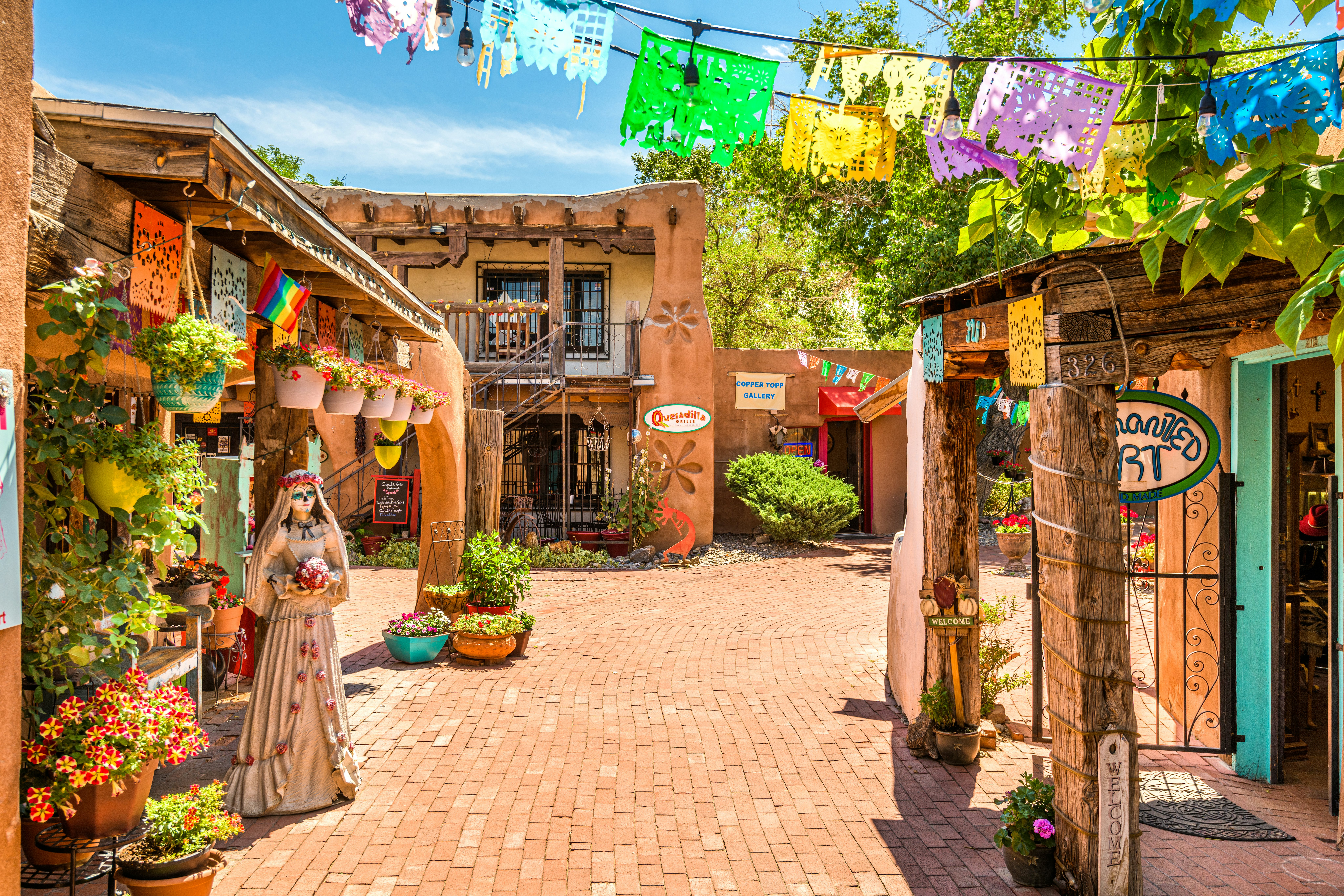
In Albuquerque, spend a morning wandering the Old Town, home to 150 independent restaurants and boutiques, plus the Rattlesnake Museum with more than 80 snakes and venomous spiders (some 10 species of rattlesnakes can be found in New Mexico).
Make sure you save time to explore the nearby Sandia Mountains, which can be ascended by numerous trails or via the 2.7-mile-long Sandia Peak Tramway, the longest in the US, to the 10,378 ft summit.
Last but not least, White Sands National Park in the southeast of the state is an anomaly and great national wonder. Just over 200 miles southeast of Albuquerque a field of white sand dunes, composed of gypsum crystals, appears. Its dune field is the largest of its kind found on Earth, with some mounds reaching 60 ft – visitors can follow marked winter trails into desert sticking and go sand-boarding on the dunes.
My favorite thing to do in New Mexico
The more than 30 miles long, 1,027 ft deep Carlsbad Caverns, in the southeastern corner of New Mexico, may be out of the way of other attractions in New Mexico, but it shouldn’t be missed. Descending 800 ft into the cave is an eerily surreal experience, with cathedral-sized rooms of lit-up skyscraper high stalagmites and stalactites that drip down from every crevice. This marvelous underworld has to be seen to be believed.
How much money do you need to visit New Mexico?
Expect to spend around $150+ per day if renting a car, eating out and staying in hotels in New Mexico. Outdoor attractions and museums are often free or inexpensive – there are 15 national parks in New Mexico so it pays to get an annual park pass ($80) if visiting three or more. If visiting a museum in New Mexico, buy a $30 Culture Pass at attractions – it offers admission to 15 museums and historic sites around the state.
Motel room: $80-200
Basic room for two: $120-300
Self-catering apartment (including Airbnb): $70-300
Public transport ticket: bus rides are free in Albuquerque
Car rental from $15 a day.
Coffee: $3-8
Sandwich: $15+
Dinner for two: $40+
Beer/pint at the bar: $7+

Things you should know about New Mexico
New Mexico is one of the younger states. It’s the US’s 47th and fifth largest state but has a comparatively small population, ranking 37th in the US for state population size with just over 2 million residents. California, in comparison, is the third largest state in area, but most populated with almost 39 million residents. Santa Fe is the oldest seat of government in the United States. People have lived in the area now known as New Mexico as long ago as 12,000 years. Tribes and descendants of Pueblos, Apache and Navajo people live in these lands. Spanish explorer Francisco Vázquez de Coronado “discovered” this area in 1540 and the area was colonized by Spain, then Mexico declared independence from Spain. The US took over the land in 1848, following the Mexican-American War in 1848. As a result, New Mexico feels culturally worlds apart from nearby states.
What is the weather like?
Temperatures in New Mexico rise to around 120°F (48°C) and have reached a low of −50°F (−45.5°C) depending on where you find yourself and when. Four fifths of New Mexico sits at a lofty elevation of over 4,000 ft above sea level. Santa Fe is the highest state capital at 7,199 ft.
Give yourself time to acclimatize when visiting and always carry lots of water in your car – and on your person if walking in the desert or at high altitudes. Wear a high factor sunscreen.
Be aware of dangerous wildlife
Those exploring the outdoors may encounter black bears, bighorn sheep, rattlesnakes, cougars, coyotes and bisons – all of which may attack when threatened. The best general advice is to keep your distance and make your presence known when on remote trails.
Don’t hike alone, talk while on trails, or carry a bear bell to alert potential animals of your presence. If you do encounter one of the above, back away slowly (or stand your ground if dealing with a cougar or coyotes, make yourself appear as large as possible, while maintaining eye contact). Never run.








